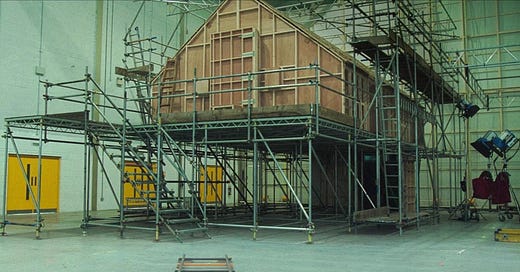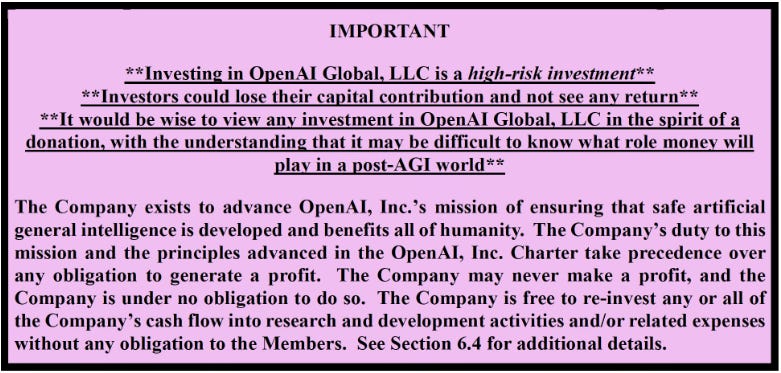Key highlights of today’s newsletter:
Business leaders are nothing without stories, they drive new investment and shape a company’s public image.
OpenAI’s raison d’etre had always been to ensure that artificial general intelligence benefits all of humanity. Its leadership crisis of last week was not the result of a conflict of interests, but of ideals.
The overarching narrative that we are asked to believe is that AGI is near, but healthy scepticism is warranted.
I watched the movie The Wonder (2022) over the weekend. It starts, rather boldly, by breaking the fourth wall. The opening scene is shot in what seems to be a large warehouse filled with film equipment. A female narrator greets the viewer and says: “This is the beginning of a film called The Wonder. The people you are about to meet, the characters, believe in their stories with complete devotion. We are are nothing without stories. And so we invite you to believe in this one.”
Breaking the fourth wall is tried-and-tested literary device. It refers to the invisible wall between the audience and the stage. By crossing it, we temporarily break the spell.
The fourth wall applies just as much to real life as it does to theater or cinema. In a way, the leadership crisis we all got to witness at OpenAI last week popped a carefully constructed bubble. For a brief moment, the actors on stage fell out of their role, it lasted for no longer than 5 days, then order was restored.
Rewriting the narrative
Business leaders are nothing without stories. They drive new investment and shape public perception.
OpenAI’s raison d’etre had always been to ensure that artificial general intelligence benefits all of humanity. It’s why the company was founded as a non-profit in 2015 and why the board was able to fire Sam Altman without having to inform anyone else upfront. Their sole responsibility is to uphold the original mission as stated in the charter.
Doing so became more complicated when, in 2019, the for-profit subsidiary was added to the mix. In order to scale, OpenAI had to raise much larger investments from companies like Microsoft, and others. And it did so very successfully. The inflow of capital allowed OpenAI to outpace the competition and capitalize on the technological progress made.
Meanwhile, it continued to operate under the guise of its original mission, which ultimately culminated in a conflict not of interests, but of ideals. The power struggle that ensued was about the founding mission of OpenAI and whether it was being a force for good in the world. Was helping one tech giant capture market share against another tech giant really in the best interest of humanity?
When the board exercised its power to oust Altman, it certainly had the right to do so, but it seemed they hadn’t anticipated the chain of events they set into motion. Satya Nadella, Microsoft’s chief executive, countered the board’s move by announcing a new internal AI lab, spearheaded by Sam Altman and Greg Brockman. Nadella was ready to hire any members from the OpenAI team that was willing to jump ship. It was widely praised as a brilliant move and in doing so Nadella saved Microsoft’s stocks from tanking when the markets opened on Monday.
And while the ousting may have surprised Altman, he didn’t looked weak for a moment. The board had stripped him of his title, but not of his power. Support for Altman, as well as offers to fund any new venture he intended to kickstart, poured in. When over 700 employees signed a letter for the board to step down, including Sutskever, who as a board member had voted to fire Altman only three days before, the faith of the board was sealed.
What’s for sure is that all of the characters involved believed in their story with complete devotion. Sutskever, Altman, Nadella, the board. All of them were convinced they doing the right thing in spite of how everything panned out.
Believers and non-believers
Another story that captivated the world, soon after the storm laid down, was the rumor of a mysterious breakthrough Q*. The speed at which the news got picked up, showed the digital grapevine in full effect. Dutch newspaper NRC Handelsblad ran a rather sensational headline: “Warning of AI breakthrough with the potential to ‘damage humanity’ led to Altman's resignation”.
was quick to point out that many stood to benefit from spreading such a rumor: it drives a ton of online engagement, diverts attention, and may even attract new investors.Who it certainly was not in the best interest of was the public. This rumor mill only further propels confusion about what AI is and isn’t, and what it can and cannot do. Even if Q* turns out to be real, in any case we should probably refrain from any excitement over it, let alone report about it in global newspapers.
To me, all of this is indicative of something bigger. The overarching narrative that we, the audience, are asked to believe is that AGI is near. And although there are believers that truly believe that, there are also many who don’t. To this day, experts exist on polar opposites of each other on the topic and don’t even agree on the most fundamental questions, like whether or not current systems really understand anything, as illustrated by
in one of his latest posts.Whether you like it of not, AGI is but a story. A very old story, in fact. One that has its roots in history, literature, and questions humanity’s place in the universe. It also happens to be part of the (very successful) brand and marketing strategy of OpenAI and other companies like it. Therefore, healthy scepticism is warranted.
We shouldn’t forget the world is a stage. When someone asks you to believe something, always ask yourself: to what end? Because in the real world, we are more than just witnesses, we are all participants.
Join the conversation 🗣
Leave comment with your thoughts. Or like this post if it resonated with you.
Get in touch 📥
Have a question? Shoot me an email at jurgen@cdisglobal.com.






There is no AGI on the horizon. OpenAI's debacle may well convince so many people to be skeptical of the doomsayers that we can all now focus on the practical benefits of the technology.